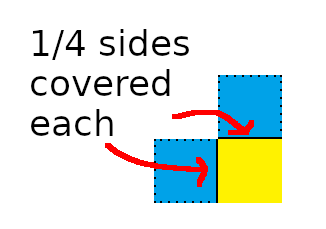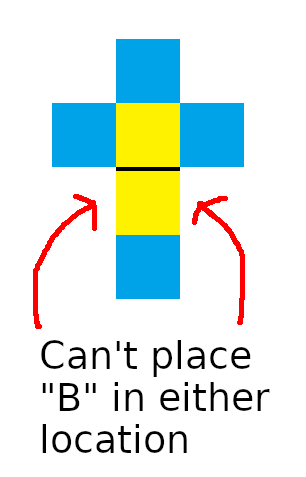Proof that the pattern found by @hexomino is optimal
Using that colour scheme, polyminos can have the following kind of internal "nodes" (up to symmetry)

We can immediately notice that:
The "A" node is illegal. 
Let's make an assumption:
The optimal pattern doesn't use the "B" node.
But then, the highest density that can be achieved is:
1/3, as the "C" and "D" nodes cover 1/2 of the sides of a monomino at the cost of 1 non-monomino node, and "E" and "F" obviously less. 
As an aside, such a pattern actually exists as well:
A staircase made out of "D"s.  , although the diagonal strips must be terminated at some point to avoid them being "infinimonos".
, although the diagonal strips must be terminated at some point to avoid them being "infinimonos".
Since we already know that there's a better density possible, the assumption is false by contradiction.
That means:
The optimal pattern must contain the "B" node.
Every "B" node must be connected to some other node, but it's only legal to connect it to "F" node, or a single place on the "E" node.

The best density we can get when we connect a "B" to an "E" is:
1/3, since no other "B"s can be connected to the same "E", making them together cover all of the sides of a monomino in total, at the cost of two nodes.  This still holds even if you try to connect other nodes, since we have already shown that they can't contribute to a density above 1/3
This still holds even if you try to connect other nodes, since we have already shown that they can't contribute to a density above 1/3
Thus, we must connect "B" nodes to "F" nodes. We know already that we can connect up to 4 "B" nodes to a "F". Since no other node can be connected to more than one "B", it's useless to connect one of them to a "F" to get more "B"s, since we would still have at most 4 "B" nodes per "F".
(This point is a bit important, because if any other node could act like a "outlet splitter" to fit more "B" nodes, we could perhaps increase the density. But only the "F" node can fit more than one "B")
This still leaves the possibility of perhaps fitting in a few extra "C", "D", "E" or "F" nodes, but since they can't contribute to a density above 1/3 without fitting in more "B"s (which we have shown is not possible), that would only make the density worse.
Since the case of connecting 4 "B" to an "F" actually is geometrically possible (it tiles), it's the optimum solution.








